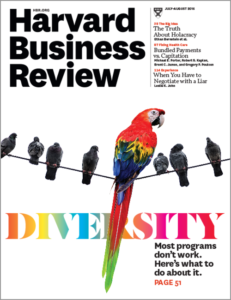
Wouldn’t it be great if our workplaces resembled the world around us?
After all, women represent 51% of the world’s population. But do you see a 50/50 split in your organization? How about at the executive level? And what about the board?
If you work in investment management, take a look around — not at the middle ranks of the organization, but at the senior level. I don’t need to tell you that there’s a gender gap. How broad is the disparity?
Oliver Wyman’s recent report on women in financial services found that only 15 percent of portfolio managers globally were women as of December 2015. (At CFA Institute, just 18% of our members globally are women.)
The good news is that many companies are trying to do something to improve diversity within their organizations. The growing interest in this topic is reflected in numerous articles, white papers, and academic research projects.
In fact, the cover of the July–August 2016 issue of Harvard Business Review featured a multi-colored parrot perched above a single word in all-caps: DIVERSITY. Two of the issue’s spotlight features paid attention to the ways that companies can put diversity to work by accessing a broader talent pool.
 In “Why Diversity Programs Fail — And What Works Better,” academics Frank Dobbin and Alexandra Kalev write that “it shouldn’t be surprising that most diversity programs aren’t increasing diversity.” The problem is that “to reduce bias and increase diversity, organizations are relying on the same programs they’ve been using since the 1960s. Some of these efforts make matter worse, not better.”
In “Why Diversity Programs Fail — And What Works Better,” academics Frank Dobbin and Alexandra Kalev write that “it shouldn’t be surprising that most diversity programs aren’t increasing diversity.” The problem is that “to reduce bias and increase diversity, organizations are relying on the same programs they’ve been using since the 1960s. Some of these efforts make matter worse, not better.”
Why is this the case? “Most diversity programs focus on controlling managers’ behavior, and as studies show, that approach tends to activate bias rather than squash it. People rebel against rules that threaten their autonomy.”
What can be done about it? “Instead of trying to police mangers’ decisions, the most effective programs engage people in working for diversity, increase their contact with women and minorities, and tap into their desire to look good to others.”
Dobbin and Kalev analyzed data from 829 midsize and large US firms to try to answer the key question in all of this: Which diversity efforts actually succeed?
Two efforts stood out: Mentoring and college recruitment targeting women. In the former, the authors note that “mentoring has an especially positive impact. Managers who sponsor women and minorities come to believe, through their increased contact, that their protégées deserve the training and opportunities they have received.” As for the latter, “college recruitment targeting women turns recruiting managers into diversity champions.”
In the same issue, Harvard Business Review interviewed Iris Bohnet, a professor and author at the Kennedy School of Government at Harvard University and author of What Works: Gender Equality by Design. Bohnet offered insights into ways that companies can structure their hiring practices to overcome hidden bias.
“Start by accepting that our minds are stubborn beasts,” says Bohnet. “It’s very hard to eliminate our biases, but we can design organizations to make it easier for our biased minds to get things right.” She tells the story of how orchestras started using blind auditions in the 1970s; the result was that the number of women in orchestras went from fewer than 10% to around 40% today.
“You can’t easily put job candidates behind a curtain, but you can do a version of that with software,” Bohnet says in her interview. There are tools “that allow employers to blind themselves to applicants’ demographic characteristics. The software allows hiring managers to strip age, gender, educational and socioeconomic background, and other information out of résumés so they can focus on talent only.”
Bohnet also recommends that companies scrutinize job ads for language that unconsciously discourages specific genders from applying. “A school interested in attracting the best teachers, for instance, should avoid characterizing the ideal candidate as ‘nurturing’ or ‘supportive’ in the ad copy, because research shows that can discourage men from applying. Likewise, a firm that wants to attract men and women equally should avoid describing the preferred candidate as ‘competitive’ or ‘assertive,’ as research finds that those characterizations can discourage female applicants.” Making conscious choices to use neutral recruitment language can mean attracting candidates from the broadest pool of applicants.
You can learn more about the effectiveness of gender-diverse teams and the ways that they can positively impact investment outcomes by reviewing some of the articles and research highlighted on this website.
On 14–15 September in Boston, CFA Institute and the Boston Security Analysts Society, Inc., will host Alpha and Gender Diversity: The Competitive Edge, a conference organized as part of the Women in Investment Management Initiative to advance the business case for diversity in the investment profession.
Please note that the content of this site should not be construed as investment advice, nor do the opinions expressed necessarily reflect the views of CFA Institute.
Photo credit: ©iStockphoto.com/Rawpixel

Recent Comments